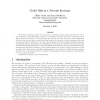Free Online Productivity Tools
i2Speak
i2Symbol
i2OCR
iTex2Img
iWeb2Print
iWeb2Shot
i2Type
iPdf2Split
iPdf2Merge
i2Bopomofo
i2Arabic
i2Style
i2Image
i2PDF
iLatex2Rtf
Sci2ools
MANSCI
2007
2007
Credit Risk in a Network Economy
We develop a structural model of credit risk in a network economy, where any firm can lend to any other firm, so that each firm is subject to counterparty risk either from direct borrowers or from remote firms in the network. This model takes into account the role of each firm’s cash management. We show that we can obtain a semi-closed form formula for the price of debt and equity when cash accounts are buffers to bankruptcy risk. As in other structural models, the strategic bankruptcy decision of shareholders drives credit spreads, and differentiates debt from equity. Cash flow risk also causes credit risk interdependencies between firms. Our model applies to the case where not only financial flows but also operations are dependent across firms. We use queueing theory to obtain our semi-closed form formulae in steady state. We perform a simplified implementation of our model to the US automotive industry and show how we infer the impact on a supplier’s credit spreads...
| Added | 16 Dec 2010 |
| Updated | 16 Dec 2010 |
| Type | Journal |
| Year | 2007 |
| Where | MANSCI |
| Authors | Didier Cossin, Henry Schellhorn |
Comments (0)

